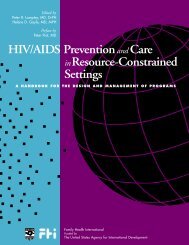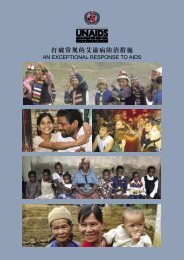The Training of Trainers Manual - UNFPA
The Training of Trainers Manual - UNFPA
The Training of Trainers Manual - UNFPA
Create successful ePaper yourself
Turn your PDF publications into a flip-book with our unique Google optimized e-Paper software.
Handout 19 • Building Effective Youth-Adult Partnerships 19<br />
In the reproductive health and HIV/AIDS fields, information about the impact <strong>of</strong> youth participation<br />
and youth-adult partnerships is limited. But literature from related fields indicates that involving young<br />
people in programmes has many benefits. Programme experience and research suggest 10 elements that<br />
lead to effective youth-adult partnerships.<br />
Clear goals for the partnership. Youth and adults should understand the reasons for and objectives <strong>of</strong><br />
the partnership.<br />
Shared decision-making power. If youth have no power to make decisions, their participation is not one<br />
<strong>of</strong> partnership.<br />
Commitment from highest level. Those in the highest level <strong>of</strong> the organization should commit fully to<br />
partnerships in order for them to be feasible and meaningful.<br />
Clear roles and responsibilities. Be clear on which youth and adults have roles in the partnership and<br />
ensure that those people understand everyone’s roles and responsibilities.<br />
Careful selection. Select the appropriate youth and adults for the partnership. Youth vary widely in their<br />
level <strong>of</strong> development and readiness to assume responsibility, and adults vary widely in their degree <strong>of</strong><br />
commitment to work with youth.<br />
Relevant training. Young people may need training in communication, leadership, assertiveness skills,<br />
and technical areas. Adults may also need training in working with youth as well as in technical areas.<br />
Awareness <strong>of</strong> different communication styles. Different styles <strong>of</strong> communication do not necessarily<br />
imply disrespect, disinterest, or different goals and expectations. Asking questions and assuming the best<br />
about others can help diffuse conflicts that arise from different communication styles.<br />
Valuing participation. Part <strong>of</strong> valuing youth involvement is to hold young people accountable for<br />
their responsibilities, just as one would with adults. <strong>The</strong> skills and commitment that adults bring to the<br />
partnership should also be valued.<br />
Room for growth. Establish ways for youth to advance to increased levels <strong>of</strong> responsibility.<br />
Awareness that youth have other interests. Youth may not be able to meet high levels <strong>of</strong> obligations<br />
because <strong>of</strong> other commitments and priorities. Work with youth to develop a level <strong>of</strong> responsibility that<br />
matches their time and commitment.<br />
Section 4. Participant Handouts<br />
171

















